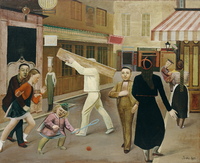The Street
Balthus

Download105011_cp.jpg (996.6Kb)
Alternative Title
La rue
Date
1933Description
The Museum of Modern Art, MoMA Highlights, New York: The Museum of Modern Art, revised 2004, originally published 1999, p. 165
Though set in a real place—the rue Bourbon-le-Château, Paris—The Street has the intensity of a dream. The figures in this strange frozen dance are precisely placed in a shallow, friezelike line, yet except for the struggling couple on the left, they don't interact at all. The toque-wearing chef isn't even human—he is a pavement sign for a restaurant—but he stands no more stiffly than the other characters, who, stylized and solid, seem less to walk than to pose.
Part of the work's tension comes from the diversity in the traditions it fuses. Its receding architectural perspective emulates Renaissance geometry, for Balthus much admired Quattrocento artists, particularly Piero della Francesca. But another, quite different influence links him to his Surrealist peers: long after painting The Street, he would still say that he had never stopped seeing things as he saw them in childhood. He well knew children's books such as Lewis Carroll's "Alice" stories, with their illustrations by John Tenniel, and, indeed, the girl caught in the tussle has been said to be Alice herself; the youth in the center resembles Tweedledum or Tweedledee; and the man with the plank could be Carroll's carpenter, without his walrus companion-though his simultaneous resemblance to a figure in Piero's Discovery and Proving of the True Cross, at Arezzo (c. 1455), suggests a different symbolic register. full view
Type of Work
Oil paintingSubject
French, Paris (France), Streetscapes, Struggle, Painting, French --20th century, Art, Modern --20th century, Surrealism
Rights
Rights Statement
Licensed for educational and research use by the MIT community only
Item is Part of
131151